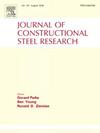负弯矩作用下基于曲率积分的钢-预应力混凝土组合梁抗弯刚度研究
IF 4
2区 工程技术
Q1 CONSTRUCTION & BUILDING TECHNOLOGY
引用次数: 0
摘要
由于钢-混凝土界面的滑移效应和混凝土板的张拉刚度效应,对钢-预应力混凝土组合梁在弯矩区抗弯刚度的准确预测具有很大的挑战性。本文提供了一种基于力学而又实用的方法来估计这种梁在使用荷载条件下的抗弯刚度。首先,建立了一种验证的弯矩-曲率法来分析梁的张拉加劲行为。分析结果表明,钢-预应力混凝土组合截面的张拉加劲效应可以忽略不计,允许将其弯矩-曲率响应理想化为考虑界面滑移效应的双线性图。随后,采用曲率积分法推导了钢-预应力混凝土组合梁的有效抗弯刚度表达式。在此基础上,提出了一种临界截面有效抗弯刚度表达式,供设计参考。最后,将所提方法的预测结果与27根组合梁的试验结果进行了对比验证。本文章由计算机程序翻译,如有差异,请以英文原文为准。
Curvature integration-based flexural stiffness of steel-prestressed concrete composite girders under negative moments
Due to the slip effect in the steel-concrete interface and tension stiffness effect in the concrete slab, accurately predicting the flexural stiffness of steel-prestressed concrete composite girders in the hogging moment region is highly challenging. This paper provides a mechanics-based yet practical method for estimating the flexural stiffness of such girders under service load conditions. Firstly, a validated moment-curvature procedure is developed to analyze the tension-stiffening behavior of the girders. The analysis results indicate that the tension stiffening effect in steel-prestressed concrete composite sections is negligible, allowing their moment-curvature response to be idealized as a bilinear graph in which the interface slip effect is considered. Subsequently, a curvature integration-based method is used to derive expressions for the effective flexural stiffness of the steel-prestressed concrete composite girder. Based on this, an expression for the effective flexural stiffness at the critical section is recommended for design purposes. Finally, the proposed method is validated by comparing its predictions against experimental results from 27 composite girders.
求助全文
通过发布文献求助,成功后即可免费获取论文全文。
去求助
来源期刊

Journal of Constructional Steel Research
工程技术-工程:土木
CiteScore
7.90
自引率
19.50%
发文量
550
审稿时长
46 days
期刊介绍:
The Journal of Constructional Steel Research provides an international forum for the presentation and discussion of the latest developments in structural steel research and their applications. It is aimed not only at researchers but also at those likely to be most affected by research results, i.e. designers and fabricators. Original papers of a high standard dealing with all aspects of steel research including theoretical and experimental research on elements, assemblages, connection and material properties are considered for publication.
 求助内容:
求助内容: 应助结果提醒方式:
应助结果提醒方式:


